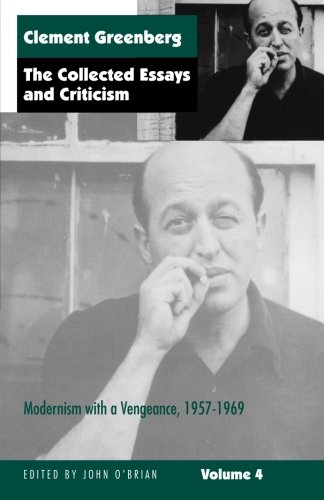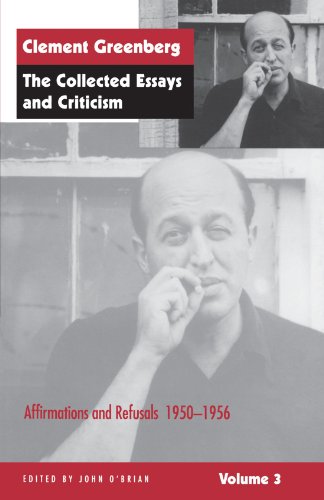Background
Clement Greenberg was born on January 16, 1909, in the Bronx in New York City. He was the oldest of three sons born to Joseph and Dora (Brodwin) Greenberg. In 1914 the family moved to Norfolk, Virginia, where his father was a storekeeper. Six years later the Greenbergs moved again, this time to Brooklyn, New York, where Joseph Greenberg became a manufacturer.
Education
Clement Greenberg was educated in public high schools and graduated from Syracuse University with a Bachelor's degree in literature in 1930. When he graduated Greenberg was unable to find a job, but during this time he studied German, Italian, French, and Latin.
Career
In 1933 he and his father began a wholesale dry goods business from which Clement resigned in 1935. A turning point for Greenberg came the following year, when he went to work for the federal government, first in the office of the Civil Service Commission and in 1937 in the Appraiser's Division of the Customs Service in the Port of New York. This latter position gave him time to begin his career as an essayist. In winter 1939 Greenberg published his first review-a commentary on Bertolt Brecht's A Penny for the Poor. This began a period of critical writing about art and culture that would span five decades. The 1940 marked Greenberg's greatest activity as a critic. From 1940 to 1942 he was an editor of Partisan Review, and from 1942 to 1949 he published regularly as the art critic for the Nation. In August 1944 he accepted the position of managing editor of the Contemporary Jewish Record. When this bimonthly magazine was replaced by Commentary, Greenberg was named associate editor, a position he held until 1957. Until 1941 Greenberg's criticism was largely confined to literary subjects. In May of that year, however, he published an appreciation of the artist Paul Klee in the Nation. This initiated the art criticism for which he became most widely known. In 1938 and 1939 Greenberg attended Hofmann's classes in which he stressed the importance of the formal qualities of painting-color, line, plane, and the "push" and "pull" of shapes on the flat canvas. In his criticism of the 1940 and the 1950 Greenberg developed these ideas into a unique critical tool. In the mid-1940 Greenberg was the first to champion the work of the New York School of abstract artists such as Jackson Pollock, Willem de Kooning, Robert Motherwell, and David Smith. When, in the 1950, the New York School of painters gained recognition, the quality of Greenberg's criticism brought him a great deal of attention. He was asked to organize exhibitions and was invited to teach and lecture at Black Mountain College, Yale University, Bennington College, and Princeton University, among others. Greenberg continued to refine his ideas about art and to write art criticism. In concise prose, Greenberg mixed references to the history of modern art and his analysis of the formal properties of painting in such a way as to make the abstract work of these artists accessible to critics and students of art. His criticism was characterized by a personal and passionate articulation of his artistic enthusiasms. In 1961 Greenberg published a collection of his essays in Art and Culture, a book that would influence the next generation of critics. In the early 1960 Greenberg also published one of his most influential essays. "Modernist Painting" outlined a formalist history in which the preoccupation of painters with the formal elements of painting, particularly the flatness of the picture plane, was the common thread of his reading of the history of modern art. From Edouard Manet to the contemporary paintings of the New York School of the 1940 and the 1950, Greenberg traced a continuous stripping away of subject matter, illusion, and pictorial space. Caught within the internal logic of their medium, painters rejected narrative in favor of painting's unique, formal qualities. With the emergence of Pop Art in the 1960 Greenberg's formalist approach was no longer relevant. Pop Art, with its reliance on conceptual wit and its sources in "low, " popular art, was the antithesis of Greenberg's formalist theories. As an answer to the success of Pop Art, in 1964 Greenberg organized the exhibition "Post Painterly Abstraction. " In the accompanying exhibition catalogue he extended his critical principles to argue that paintings exhibiting openness, linear clarity of design, and high-keyed, even-valued color were the natural progression of the formal history of art that he had outlined earlier in "Modernist Painting. " Despite his arguments, Greenberg's emphasis on a formalist interpretation came under increasing criticism during the 1970 and the 1980. Even to his challengers, however, Greenberg remains one of the most important critics of his time. All recognize that he articulated clearly and concisely an approach to art that has remained prevalent for almost half a century.
Views
The intellectual justification for his approach had been articulated a few years earlier in two essays published in Partisan Review. "The Avant Garde and Kitsch" (1939) was a manifesto in which Greenberg made a sharp distinction between "true culture" and "popular art. " He asserted that quality in a work of art had nothing to do with contemporary social and political values. "Retiring from the public altogether, " he wrote, "the avant-garde poet or artist sought to maintain the high level of his art by both narrowing it and raising it to the expression of an absolute. .. ." This was necessary, he argued, because of the ways in which modern society had debased high art into kitsch. In "Towards a Newer Laocoon" (published in Partisan Review in 1940) Greenberg explained the necessity for avant-garde artists to break away from the traditional dominance of subject matter and place a new emphasis on form. Greenberg's early thinking was influenced by the theories of Karl Marx and Hans Hofmann. Greenberg's study of Marxist theory made the avant garde of interest to him, and it suggested that abstract art was a revolutionary move away from the popular appeal of narrative painting in America. More important, however, was the influence of Hans Hofmann, the German artist and educator.
Quotations:
"Where the Old Masters created an illusion of space into which one could imagine walking, the illusion created by a Modernist is one into which one can look, can travel through, only with the eye. "
"The peasant finds no "natural" urgency within himself that will drive him toward Picasso in spite of all difficulties. In the end the peasant will go back to kitsch when he feels like looking at pictures, for he can enjoy kitsch without effort. "
"The main trouble with avant-garde art and literature, from the point of view of fascists and Stalinists, is not that they are too critical, but that they are too "innocent, " that it is too difficult to inject effective propaganda, that kitsch is more pliable to this end. "
"The difficulty of carrying on a leisure-oriented tradition of culture in a work-oriented society is enough in itself to keep the present crisis in our culture unresolved. "
"Where Picasso paints cause, Repin paints effect. Repin predigests art for the spectator and provides a short cut to the pleasure of art that is necessarily difficult in genuine art. Repin, or kitsch, is synthetic art. "
"Photography is the most transparent of the art mediums devised or discovered by man. It is probably for this reason that it proves so difficult to make the photograph transcend its almost inevitable function as document and act as a work of art as well. "
"Realistic, naturalistic art had dissembled the medium, using art to conceal art; Modernism used art to call attention to art. "
"The dissolution of the pictorial into sheer texture, into apparently sheer sensation, into an accumulation of repetitions, seems to speak for and answer something profound in contemporary sensibility. "
"You like it, that's all, whether it's a landscape or abstract. You like it. It hits you. You don't have to read it. The work of art-sculpture or painting-forces your eye. "
"I don't get into 'becauses. ' When you come into a studio you see a number of works. My habit is to go to the one I like most. If you start to say, 'because, ' you get into art jargon. "
"A poor life is lived by any one who doesn't regularly take time out to stand and gaze, or sit and listen, or touch, or smell, or brood, without any further end in mind, simply for the satisfaction gotten from what is gazed at, listened to, touched, smelled, or brooded upon. "
Connections
Greenberg married in 1934, had a son the next year, and was divorced the year after that.









